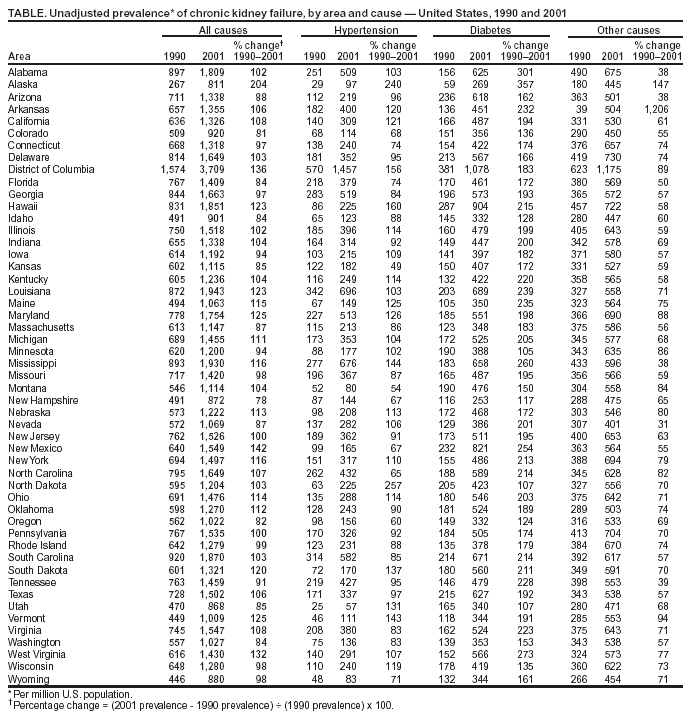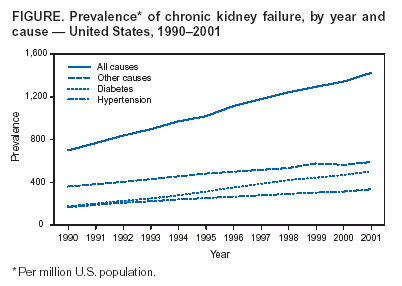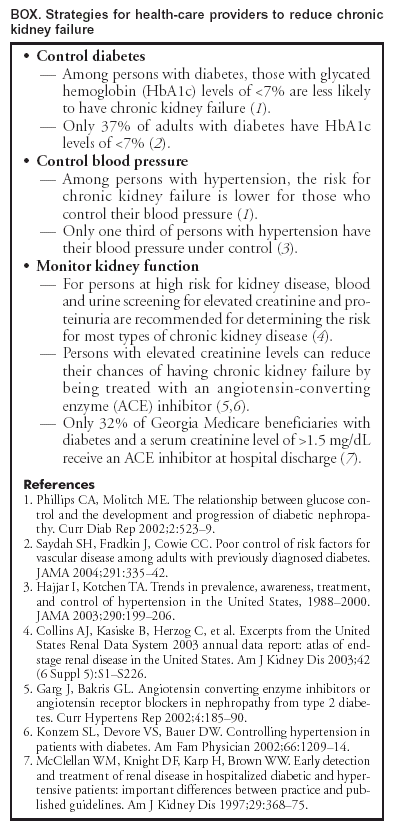 |
|
|
|
|
|
|
|
|
|
|
|
|
|
|
|
|
||||
| ||||||||||
|
|
|
|
State-Specific Trends in Chronic Kidney Failure ---United States, 1990--2001Kidney disease is the ninth leading cause of death in the United States (1). Approximately 19 million U.S. adults have chronic kidney disease (2), and an estimated 80,000 persons have chronic kidney failure diagnosed annually (3). Major causes of chronic kidney failure are diabetes mellitus and hypertension, which account for approximately 60% of new cases (3). To assess national and state-specific trends in the prevalence of chronic kidney failure during 1990--2001, CDC analyzed data from the United States Renal Data System (USRDS). This report summarizes the results of that analysis, which indicated that the prevalence of chronic kidney failure in the United States increased 104% during 1990--2001. Treating and controlling risk factors and screening persons at high risk for chronic kidney failure are key steps that health-care providers and public health practitioners can take to reverse the upward trend in this disease. Data from the Renal Data Extraction and Referencing System (RenDER), version 2.0, were used to document state-specific trends in the prevalence of chronic kidney failure during 1990--2001. RenDER is an online data-querying application that enables users to access information regarding chronic kidney failure (4). Data obtained from RenDER originate from several sources, including the Centers for Medicare and Medicaid Services, and encompass all persons being treated for chronic kidney failure in the United States. Overall and state-specific trends in the prevalence of chronic kidney failure are presented for all causes and by the diagnosed cause of the kidney disease: diabetes, hypertension, and other (i.e., all causes except diabetes or hypertension). During 1990--2001, the national prevalence of chronic kidney failure (from all causes) increased 104%, from 697 to 1,424 cases per million population (Figure). The largest increase was in the prevalence of diabetes-related chronic kidney failure, which increased 194%, from 171 to 503 cases per million population. The prevalence of hypertension-related chronic kidney failure increased 99% (from 166 to 331 cases per million population), and the prevalence of chronic kidney failure related to other causes increased 64% (from 360 to 590 cases per million population). During 1990--2001, the prevalence of chronic kidney failure increased in all 50 states and the District of Columbia (DC) (Table). In 2001, the total prevalence of chronic kidney failure and the prevalence of hypertension-related chronic kidney failure were highest in DC, Louisiana, and Mississippi; the prevalence of diabetes-related chronic kidney failure was highest in DC, Hawaii, and New Mexico; and the prevalence of chronic kidney failure related to other causes was highest in DC, Delaware, and Hawaii. Reported by: CJ Pirtle, Spelman College, Atlanta, Georgia. AC Schoolwerth, MD, Dartmouth-Hitchcock Medical Center, Lebanon, New Hampshire. WH Giles, MD, DW Brown, MSPH, AH Mokdad, PhD, ES Ford, MD, Div of Adult and Community Health, National Center for Chronic Disease Prevention and Health Promotion, CDC. Editorial Note:During 2001, expenditures for chronic kidney failure in the United States exceeded $20 billion (3), and Medicare payments for chronic kidney failure increased threefold during 1991--2001, from $5.8 billion to $15.4 billion (5). The findings in this report indicate that the prevalence of chronic kidney failure more than doubled during 1990--2001. Potential explanations for this increase include 1) an increase in the prevalence of underlying risk factors, including diabetes and hypertension (6,7); 2) the aging of the U.S. population; and 3) a higher survival rate among persons with chronic kidney failure (3). The prevalence of chronic kidney failure varied substantially by state/area. This variation might reflect differences in sociodemographics factors (e.g., age, sex, race/ethnicity, and economic resources); the prevalence of diabetes, hypertension, obesity, and other risk factors for chronic kidney failure; and availability of and access to health care among patients with chronic kidney disease. Health-care providers can use various strategies to reduce chronic kidney failure (Box). The findings in this report are subject to at least two limitations. First, although USRDS has made progress in identifying and eliminating duplicate cases of chronic kidney failure, the possibility of duplicate cases remains (3), and such duplication would have led to an overestimate of the prevalence of disease. Second, the analysis did not adjust for age. Because age is a risk factor for chronic kidney failure, the aging of the U.S. population might result in an increase in the prevalence of disease. However, when the data were analyzed through direct standardization of the survey population to the age distribution of the 2001 U.S. population, prevalence trends were similar to those presented in this report, with the overall prevalence of chronic kidney failure increasing 96% during 1990--2001. Reducing kidney failure in the United States will require additional public health efforts, including effective prevention strategies such as the promotion of regular physical activity and a healthy diet. In addition, prevention, treatment, and control of risk factors for chronic kidney disease, particularly diabetes and hypertension, are important. Heightened awareness about chronic kidney disease, its causes, signs, and symptoms, and the importance of early detection and treatment also are effective strategies for reducing the prevalence of chronic kidney failure. References
Table  Return to top. Figure  Return to top. Box  Return to top.
Disclaimer All MMWR HTML versions of articles are electronic conversions from ASCII text into HTML. This conversion may have resulted in character translation or format errors in the HTML version. Users should not rely on this HTML document, but are referred to the electronic PDF version and/or the original MMWR paper copy for the official text, figures, and tables. An original paper copy of this issue can be obtained from the Superintendent of Documents, U.S. Government Printing Office (GPO), Washington, DC 20402-9371; telephone: (202) 512-1800. Contact GPO for current prices. **Questions or messages regarding errors in formatting should be addressed to mmwrq@cdc.gov.Page converted: 10/7/2004 |
|||||||||
This page last reviewed 10/7/2004
|